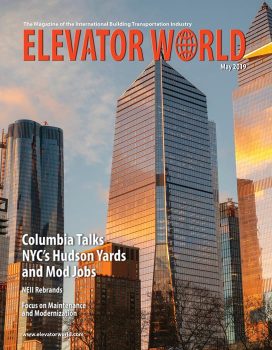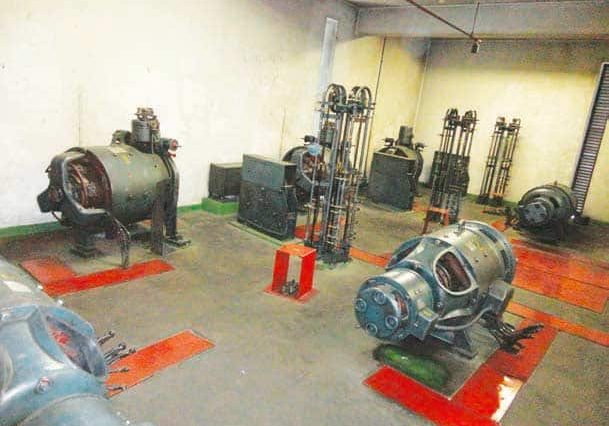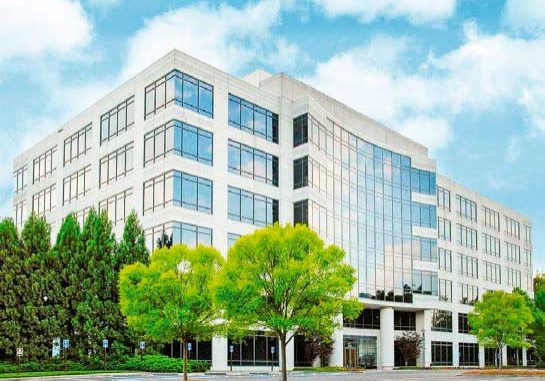Rebranding reflects a restructured NEII that promises to be a more focused, proactive voice for the industry.
The National Elevator Industry, Inc. (NEII) formally launched a new logo, tagline and website during its annual general meeting on April 23, representing the culmination of a transition that started approximately eight years ago and ushering in a new era for the 105-year-old organization — one that Executive Director Karen Penafiel describes as much more coordinated, effective and proactive. Penafiel came on about two-and-a-half years ago as NEII’s first full-time employee. Her first order of business was to transition consultants Amy Blankenbiller and Kevin Brinkman, who had been performing work related to government affairs and codes, respectively, to full-time employees. Blankenbiller was promoted to vice president of Government Affairs and Brinkman to vice president of Codes and Safety in early 2017. At that time, Penafiel rounded out the staff by hiring Nicole Van Velzen as director of Communications, Dylan Isenberg as director of Government Affairs and Megan Hensley, who provides research support to the Codes and Safety, Government Affairs and Communications departments as project manager. Penafiel, who calls the launching of the website and the rebranding “the final piece of the puzzle” of the “new NEII” says:
“The thinking by the Board of Directors was that this would give us the capability to be much more coordinated, e.ffective and proactive. The prior structure forced us to be more reactive. We just had to wait until things were happening to our members and work to address those issues the best we could. Elevator regulations are typically not national issues. They are state or local in scope. It is very hard to watch every jurisdiction and know what is going on. The outcome of these issues heavily impacts our member companies.”
Having more staff and all these feet on the ground throughout the U.S. lends itself to keeping the NEII “o–ce” 100% remote, with Penafiel based in Centreville, Virginia; Brinkman in Eureka, Illinois; Blankenbiller in Topeka, Kansas; Hensley and Van Velzen in Lawrence, Kansas; and Isenberg in Washington, D.C. Team members talk to each other “constantly,” Penafiel says, with staff conference-call or Skype meetings taking place biweekly. In March, Penafiel, Blankenbiller, Brinkman and Isenberg were preparing to travel to government affairs and central code committee meetings Fort Lauderdale, Florida. “We always schedule time to compare notes after those meetings to verify what we heard and make sure we’re very clear on what our members have requested of us,” Penafiel says.
NEII has approximately 30 member companies and industry partners, including all of the big multinational companies. NEII companies represent more than 80% of the total hours worked within the elevator and escalator industry, and employ more than 25,000 people in the U.S. Most members are union signatories, and the organization has quite a bit of interaction and works very closely with the International Union of Elevator Constructors (IUEC). When the IUEC initiated its first-ever Stand Up for Safety Day in fall 2018, the majority of NEII’s signatory union companies participated. “Our shared goal was to provide some coordinated messaging to all of the workforce, basically saying that the union and the employers are all on the same side of safety and to make sure everybody heard that message,” Penafiel says.
Coordinated messaging is something NEII wants to build on, participating in such events as NAESA International’s Safety Summit (ELEVATOR WORLD, August 2017). Penafiel says NEII plans to be involved in future such events. “One of my roles is to interface with the other organizations and try as much as possible to know what everyone else is doing to complement their efforts, especially when it comes to safety,” she says.
“We want to convey that our members are the innovators of our industry. ” — NEII Executive Director Karen Penafiel
In addition to the evergreen issue of safety, NEII’s core issues include driving the adoption of model codes, maximizing choice for building transportation systems and advancing innovation and performance. “Our members are very innovative, and there are constantly new products in the pipeline,” Penafiel says. “Ensuring these advancements are recognized in code development is a huge issue for us.” NEII strives to make sure multiple jurisdictions aren’t imposing additional layers of regulation on these products or restricting choice.
Machine-room-less elevator systems are one such group of products. Previous years have seen rumblings about California drafting codes that would restrict MRLs. Penafiel says NEII continues to keep a close eye on those developments, stating:
“California has been in the process of updating their codes for several years now, and part of that revised code would limit the use of MRLs in a way that is more restrictive than the current practice allowed by the state. We anticipate California will come out with a proposed rule in the next couple of months, but we don’t know exactly what it is going to contain.
“One of the points we have been making to California policy makers is that so much time has gone into developing regulations to update their codes that the proposal, which has been based on the 2013 edition of ASME A17.1/CSA B44 codes, will be out of date when proposed. We’re working with them and numerous other states to review and update state elevator codes. The best-case scenario would be for states to adopt current national codes to promote safety so our members do not have to manufacture di.fferent products or variations of products for di.fferent jurisdictions. Di.fferent code editions and modiflcations to state or local codes can cause confusion and increase costs for building owners and developers.”
The best-case scenario would be for states to adopt current national codes so our members do not have to manufacture different products or different variations of products for different jurisdictions. ” — Penafiel
NEII was founded in 1914 as Elevator Manufacturing Industry, a manufacturers’ association that was the first to publish a model elevator code that predated those of ASME. In the 1930s, the name changed to the National Elevator Manufacturing Industry, becoming NEII in 1969. During the current rebranding process, the idea to change the name again was floated, but ultimately decided against. Penafiel says:
“At the end of the day, our board decided we have a very strong identity as NEII. Anything we had to gain from changing the name could be lost by creating confusion. We updated the old black and red logo in favor of a much more modern and refreshed look to convey that our members are the innovators of our industry. We are a contemporary industry with cutting-edge technologies and needed the look of our logo and website to present a clear message.”
Now, when people look at the website or a NEII representative’s business card, they see artful but easy-to-read lettering in shades of navy, yellow and white. The new tagline is, “Setting standards in motion.” The website has thoughtfully designed, visually appealing sections on advocacy, codes, communications, innovations and safety.
The website complements the on-the-ground communication NEII is tackling with renewed vigor. Penafiel says the team is focusing on open communication with employees of member companies so these employees can directly convey what’s happening on local levels. “If they feel like a code enforcement isn’t consistent, for instance, they let us know,” Penafiel says. “Or if a local elevator board is considering some regulations or policy changes, they may be able to give us a heads-up on those issues.”
In states and cities that have elevator boards, NEII studies the makeup of those boards to ensure members’ interests are being properly represented. These boards typically have a building owner and an elevator manufacturer, among other designated seats. NEII’s mission, Penafiel says, is “to make sure elevator manufacturers are represented by a qualified individual and the boards collectively can have thoughtful and thorough conversations on any policy changes that impact our industry.”
Get more of Elevator World. Sign up for our free e-newsletter.










